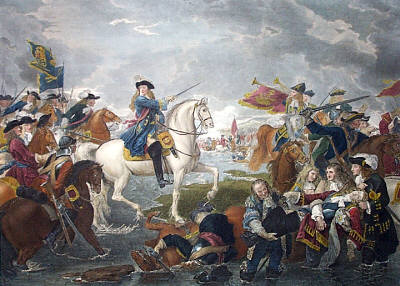
"Battle of the Boyne"
Ref: TR-C274
by Benjamin West
Plate mark size: 20 x 25 inches - (approx 51
x 64 cm)
Battle of the Boyne, 1 July 1690
Battle at which William III defeated the army gathered by the deposed James II in Ireland. The battle was not decisive, and much of the Jacobite army was able to escape the field. However, James fled to France, leaving William free to pacify Ireland
Both kings commanded their armies in person. William had 36,000 men and James had 25,000 - the largest number of troops ever deployed on an Irish battlefield. English, Scottish, Dutch, Danes and Huguenots (French Protestants) made up William’s army (Williamites), while Jame’s men (Jacobites) were mainly Irish Catholics, reinforced by 6,500 French troops sent by King Louis XIV. At stake were the British throne, French Dominance in Europe and religious power in Ireland.
William’s camp was on the north side of the river. James’s was on the south side with the two armies facing each other. William’s battle plan was to trap the Jacobite army in a pincer movement. He sent 10,000 men towards Slane which drew the bulk of the Jacobities upstream in response. With 1,300 Jacobites posted in Drogheda, only 6,000 were left at Oldbridge to confront 26,000 Williamites. All the fighting took place on the south side of the river as the vastly outnumbered Jacobite defended their position against the advancing Williamites. William himself crossed at Drybridge with 3,500 mounted troops.
The princer movement failed. King James’s army retreated across the River Nanny at Duleek and regrouped west of the Shannon to carry on the war.
Approximately 1,500 soldiers were killed at the Boyne
